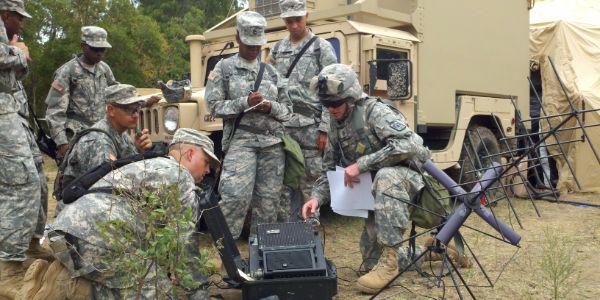IoT Stars Aligning for Soldier SATCOM on the Ground
Technological leaps in ground station capabilities, such as interference cancellation, band diversity and phased array antennas, will allow the U.S. Army to use new Internet of Things satellite constellations to boost combat communications. New technologies offer lower latency, higher throughput and greater network resilience while being easier for soldiers to use.
Recent Army experiments, including the Network Modernization Experiment (NetModX) and Project Convergence, have included a range of technologies for enhancing and protecting satellite communications (SATCOM). The technologies will support Army modernization goals, including a more resilient network, long-range precision fires and air and missile defense.
With Russia, China and the United States racing to develop and deploy hypersonic missiles capable of traveling at more than five times the speed of sound and hitting targets literally thousands of miles away, reliable, long-range communication becomes more essential than ever. “Having that real-time information, eyes-on information, or just-in-time information is critical,” says Chief Warrant Officer 5 Chris Westbrook, senior technical advisor, Army Network Cross-Functional Team.
CW5 Westbrook emphasizes the precision part of the Army’s long-range, precision fires vision. “We have spent an enormous amount of effort over the last 20 years to be able to have more precise fires, so you reduce the damage to local communities, the damage to noncombatants. We want to make sure we’re hitting the enemy and just the enemy, if that’s within our ability to do so. So, we have to have all of the pertinent facts—the relevant, time-sensitive facts—able to be distributed.”
Enhanced SATCOM also will allow a more effective call-for-fires process and damage assessment following a strike, he points out.
To achieve its goals, the service is exploring new satellites being launched to allow Internet of Things capabilities for commercial and private use. Companies such as SpaceX, Telesat, ViaSat and Inmarsat are competing to provide coverage across the planet.
Researchers see breakthroughs in a wide range of technologies that will help the service create a more resilient SATCOM network in the future. “There’s things like passive phased arrays and lens technologies, new manufacturing processes, new and cheaper chip sets with different properties that all are combining to make this a feasible thing for us to do,” says Rich Hoffman, protected SATCOM lead within the Army’s C5ISR (Command and Control, Communications, Computers, Cyber, Intelligence, Surveillance and Reconnaissance) Center. “A couple of years ago—or even right this minute—we could develop a capability like this, but it would be too expensive for us to field.”
However, military forces face more significant challenges than the average cellphone user. For example, warfighters must communicate while on the move, and they need equipment tough enough to endure harsh battlefield conditions. “We have other requirements like on-the-move, ruggedization and security. Right now, we’re evaluating all these outstanding new technologies,” Hoffman adds. “They’re making things cheaper. They’re making things faster. They’re even making things more protected in some cases.”
The overall goal for protected SATCOM is an easy-to-use network that offers enhanced resiliency. “This means automated systems protecting links and managing connections to build a resilient network for the soldiers and the Army applications required to fight,” Hoffman explains. “We started out with a detailed threat analysis for threats today and into the future, and we came up with a multitiered approach to adding resiliency to wideband SATCOM.”
Fortunately for future warfighters, those advances in space are accompanied by advances on the ground. The envisioned resilient SATCOM network includes two parts. The first involves processing technologies to support link protection, including interference cancellation. When that is not enough, warfighters will rely on multiple connections that are autonomously managed—a concept known as resiliency through diversity.
Some initial technologies for protecting SATCOM may be fielded in 2021 and 2023, but the Army also is developing more integrated, next-generation tactical ground terminals, which could be fielded in 2025 and 2027 as part of Capability Sets 25 and 27. “This will allow soldiers to support on-the-move operations and at-the-halt operations and support multiple connections simultaneously,” Hoffman says.
The service may need to develop a family of ground terminals with different capabilities. For example, terminals designed for on-the-move communications might be integrated onto tactical vehicles, which Hoffman describes as “a whole science in and of itself with ‘severe limitations’ and tons of integration issues,” such as cabling. Terminals designed for at-the-halt SATCOM, on the other hand, could be mounted onto trailers and have limited power but added flexibility.
Potentially, different units may receive terminals with different capabilities. “It might be a family of ground terminals leveraging the same technologies. And in some cases, less integration may be okay. An expeditionary unit is a lot different than a heavy brigade looking to fight with heavy vehicles,” Hoffman states. “The major challenges for us are meeting our goals in a size, weight, power and cost environment, especially SATCOM on the move.”
The researchers are working with BAE on an interference canceller to protect against jamming and other forms of interference. It is known as Wideband SATCOM Interference Cancellation (WSIC). They also are working with CloudJuncxion, a small business, to build a system known as Broadband Diversity. “This is a one-network interface, and right now, it’s multiple terminals supporting multiple connections, so we take one network interface to multiple satellite terminals and show those links all working together. Then we take links down and put them up and show how that manager always provides the optimal bandwidth back to the user,” Hoffman explains. “That’s getting ready for when we have that integrated terminal. We have this type of technology to manage all of those connections, but it’s all one terminal instead of these multiple terminals.”
While Army officials hope to make changes, the technology so far is working well. “The virtual baseband diversity is really at a point where it’s working. There are things we want to add to it to manage it more effectively going forward, and the interference cancellation right now supports point-to-point links. We’re going to apply this to other types of waveforms in the future,” Hoffman reports.
CW5 Westbrook stresses the need to make the technology as easy as possible for soldiers to use. “I think my job is to work myself out of a job to where it’s just like your cellphone where … the regular ground-pounding warfighters can set it up and employ it on their own.”
Automation will be a key piece of that ease-of-use capability. Army officials have been touting an artificially intelligent system for determining which network is best under any given circumstance and automatically routing traffic through it. The capability is known as automated PACE planning, which refers to primary, alternate, contingency and emergency communications. “The technology we’re looking at for this is almost [automated] PACE on steroids. It autonomously looks at all the links you have and automatically uses the links available and provides the best bandwidth possible to the soldier autonomously,” Hoffman offers.
CW5 Westbrook explains that different satellite constellations work best under different circumstances. Constellations with high latency rates are not ideal for “live services,” such as voice and video but can be fine for normal web browsing.
“The ability for an intelligent engine to take a look at the traffic type and pick the best path for it is extremely important. You don’t want to clog up a pipe with all types of traffic when some are better suited for others.”
For example, with systems that have a high delay or high loss, the service can use transmission control protocol traffic while sending voice and video traffic over another link. “It just makes perfect sense and is the best utilization of the bandwidth we have available,” the chief says.
Breakthroughs in antenna technologies, such as phased arrays, also will help the Army achieve its protected SATCOM goals. “There are incredible emerging technologies that are just cracking some eggs. We’ve been looking at things like phased arrays for literally decades. It was always almost ready, almost ready, but now with these mega-constellation investments, really, it’s a cost thing. It’s getting it down to a point where we’ll be able to leverage this stuff,” Hoffman reports.
The chief warrant officer emphasizes that cost matters. “There is a tremendous amount of different types of technologies and approaches out there in the world of antennas. It’s just a matter of two things: finding the best of breed [technology] and then, of course, being able to find the affordable solution at the scale we want. If we’re looking at Army-wide scale of implementation, and the cost is exorbitant, there’s just no way it can be sustainable for us.”
But, he adds, with additional research and development, electronically steerable phased arrays may find more use in the Army. “They’ve existed for years on satellites to service the globe; however, to get them down to the size and scale we want takes significant science and research and time and effort. That’s one of the limiting factors, but as these things mature and the [science and technology] community can help us figure out those target points, we can be sure we’re going to get the affordable best of breed to put in our capability sets.”
Just as the military has different technical requirements for SATCOM than does the civilian world, it also has distinct reasons for wanting those communications to be resilient. “We do know the best way to make somebody’s day bad is to remove their communications. If you lose your cellphone, it’s going to be a bad day for you. If you lose your work computer, it’s going to be even worse,” says CW5 Westbrook. “When we make our networks more robust, more capable, more resilient…that allows us to have multiple options so that we can react to whatever the enemy is trying to do to us.”






Comment
I found it interesting that
I found it interesting that nowhere in the article above is there mention of the secure, mobile and near-global voice, video, and data capabilities available on orbit today, i.e. the Mobile User Objective System (MUOS). While wideband systems in the commercial marketplace are growing with significant potential for DoD use, Wideband Code Division Multiple Access (WCDMA) comms over UHF provide our warfighters with the benefits of using that spectrum, and is operational today.
Comments